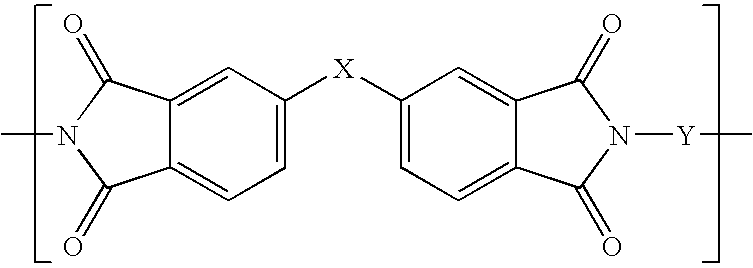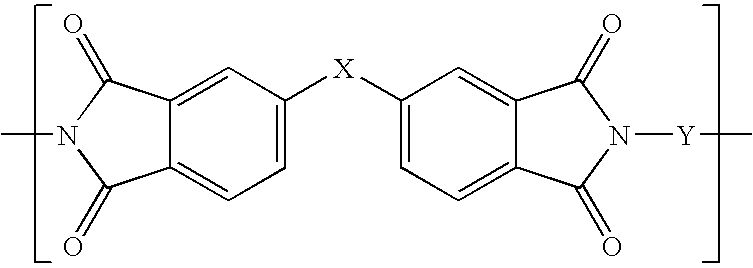Composition of polyimide and sterically-hindered hydrophobic epoxy
a technology of hydrophobic epoxy and polyimide, which is applied in the direction of metal layered products, non-conductive materials with dispersed conductive materials, synthetic resin layered products, etc., can solve the problems of resistance properties that can be difficult to achiev
- Summary
- Abstract
- Description
- Claims
- Application Information
AI Technical Summary
Benefits of technology
Problems solved by technology
Method used
Image
Examples
example 1
[0076]A polyimide was prepared by conversion of a polyamic acid to polyimide with chemical imidization. To a dry three neck round bottom flask equipped with nitrogen inlet, mechanical stirrer and condenser was added 800.45 grams of DMAC, 89.98 grams of 3,3′-bis-(trifluoromethyl)benzidine (TFMB), 3.196 grams 3,3′-dihydroxy-4,4′-diaminobiphenyl (HAB) and 0.878 grams of phthalic anhydride (to control molecular weight).
[0077]To this stirred solution was added over one hour 104.87 grams of 3,3′,4,4′-diphenylsulfone tetracarboxylic dianhydride (DSDA). The solution of polyamic acid reached a temperature of 33° C. and was stirred without heating for 16 hrs. 119.56 grams of acetic anhydride were added followed by 109.07 grams of 3-picoline and the solution was heated to 80° C. for 1 hour.
[0078]The solution was cooled to room temperature, and the solution added to an excess of methanol in a blender to precipitate the product polyimide. The solid was collected by filtration and was washed 2 ti...
example 2
[0079]EXAMPLE 2 illustrates the use of a high Tg crosslinkable polyimide used in a PTF resistor composition that contains hydrophobic thermal crosslinkers. A PTF resistor paste composition was prepared using the polyimide solution of EXAMPLE 1. This was performed by adding, to the polyimide solution, the additional components listed below, including but not limited to, a hydrophobic epoxy and electrically conductive materials.
[0080]The PTF resistor paste included one or more metal powders (or metal oxides), hydrophobic thermal crosslinkers, and an aromatic amine catalyst. The PTF resistor paste composition was prepared by mixing the following ingredients in an ambient environment with stirring to give a crude paste mixture.
[0081]
Ingredient% by weightRuthenium dioxide powder28.13Bismuth ruthenate powder16.25Graphite1.52Alumina powder10.13Polyimide solution38.50Tetramethylbisphenol A0.98RSS-1407 (epoxy)1.48Desmodur ® BL4265A solution1.03Dimethylbenzylamine0.06Borchi KAT 220.082-MB0.03...
example 3
[0083]The PTF resistor paste of EXAMPLE 2 was used to prepare a PTF resistor. The PTF resistor paste was printed directly onto chemically cleaned copper without a silver immersion process. Silver immersion processes are typically used to pre-treat a copper surface.
[0084]The PTF resistor paste was 3-roll milled with a 1 mil gap with 3 passes each set at 0, 50, 100, 200, 250 and 300 psi pressure to yield a fineness of grind of 7 / 3. The paste was screen-printed using a 280-mesh screen, an 80-durometer squeegee, on print-print mode, at 10-psi squeegee pressure, on chemically cleaned FR-4 substrates, and with a 40 and 60 mil resistor pattern.
[0085]The samples were baked in a forced draft oven at 170° C. for 1 hr followed by 2 min at 230° C. cure in air. The properties of the resulting cured PTF resistor were recorded as follows:
[0086]
Resistance (ohm / square)129Thickness (microns)15HTCR (ppm / ° C.)190CTCR (ppm / ° C.)−105% resistance change of 40 mil resistors after:Brown oxide−0.48Lamination...
PUM
| Property | Measurement | Unit |
|---|---|---|
| boiling point | aaaaa | aaaaa |
| boiling point | aaaaa | aaaaa |
| boiling point | aaaaa | aaaaa |
Abstract
Description
Claims
Application Information
 Login to View More
Login to View More - R&D
- Intellectual Property
- Life Sciences
- Materials
- Tech Scout
- Unparalleled Data Quality
- Higher Quality Content
- 60% Fewer Hallucinations
Browse by: Latest US Patents, China's latest patents, Technical Efficacy Thesaurus, Application Domain, Technology Topic, Popular Technical Reports.
© 2025 PatSnap. All rights reserved.Legal|Privacy policy|Modern Slavery Act Transparency Statement|Sitemap|About US| Contact US: help@patsnap.com



